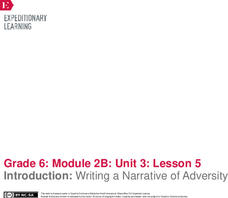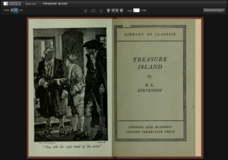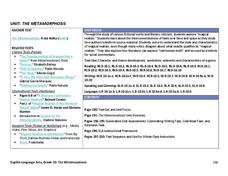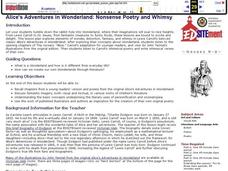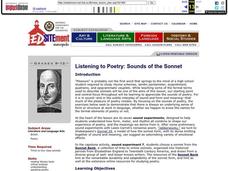National Endowment for the Humanities
Emulating Emily Dickinson: Poetry Writing
High schoolers analyze mood and voice in Emily Dickinson's poem, "There's a Certain Slant of Light." After the analysis, students write a poem of their own emulating the Dickinson poem, and then write a one-page essay describing what...
National Endowment for the Humanities
In Emily Dickinson's Own Words: Letters and Poems
Analyze the depth and beauty of American Literature by reading Emily Dickinson's letters and poems. The class analyzes Dickinson's poetic style and discusses Thomas Wentworth Higginson's editorial relationship with Dickinson. They pay...
Great Schools
Different Types of Writing
What type of writing is this? Learners read a brief introduction to various types of text: instructions, explanations, poems, folk tales, novels, informative, and arguments. The introduction doesn't explain these, so consider going over...
Curated OER
Lincoln is in the House! ("Name-Dropping" Poems and the Power of Connotation)
“What’s in a name?” Just about everything. Barack Obama, Vincent van Gogh, Justin Bieber. Famous names evoke a multitude of reactions and poets often use the names of famous people in their works precisely because names carry...
EngageNY
Introduction: Writing a Narrative of Adversity
A little adversity is good for writing. Scholars review narrative-based monologues and concrete poems and choose which genre to use to express their own theme of adversity. Pupils also consider how to structure their narratives by...
Library of Congress
Treasure Island
For 30 years, Long John Silver has sailed the seas. An eBook version of Treasure Island introduces readers to the tales Long John Silver has to tell. This 1883 version of the text includes an introduction to encourage critical thinking...
Curated OER
Acrostic Poetry to Teach Font Changes and Centering
Young scholars engage in a discussion about how to write an acrostic poem. They demonstate the ability to use a word processor by typing an acrostic poem by following instructions. Word processing skills such as, centering text, changing...
Curated OER
Annotating Poetry
Use text marking and highlighting to explore the structure of a poem. After listening to Allan Ahlberg read "Please Mrs. Butler," learners locate stanzas and patterns on their copy of the poem using the text marking technique. Class...
Curated OER
Teaching the Holocaust Through Poetry
W.H. Auden’s poem “Refugee Blues” launches a study of the problems of refugees. Background information about the poem and general information about Jewish refugees from Germany and Austria are provided, as are discussion questions and...
Louisiana Department of Education
The Metamorphosis
How can something be true even if it didn't happen? Invite your classes to investigate the truths found in the world of magical realism as they analyze short stories, poems, informational texts, video, and art from this genre.
Curated OER
So Much Depends Upon...Sixteen-Word Imagery Poems Inspired by Love that Dog by Sharon Creech
After reading Love That Dog by Sharon Creech (and possibly shedding a few tears), middle schoolers work on their own sixteen-word poems with a Six Trait writing activity. They focus on word choice in this activity to capture an...
Curated OER
Alice's Adventures in Wonderland: Nonsense Poetry and Whimsy
Primary learners are introduced to Lewis Carroll's whimsical poetry. They read "The Nursery Alice" Carroll's adaptation for younger readers, view story illustrations, listen to poetry and write whimsical verses of their own about food.
Curated OER
Discussing Poetry In Class
Students investigate syllabic metre and rhyming techniques by analyzing poetry. In this language arts activity, students read the poem Considering the Snail and discuss the nature and mood of the poem with their classmates. Students...
Curated OER
Creating a Found Poem
Teach your English learners about theme through this found poem project. Class members read two versions of O. Henry's "The Gift of the Magi": the original version and a synopsis. After learning about themes and connecting theme to their...
Curated OER
Extreme Poetry Vocabulary
Challenge your class with this comprehensive list of literary vocabulary words. Learners take a pre-test, look up definitions, come up with an example, and then take a post-test. You might use this prior to a unit about poetic devices in...
Curated OER
Modernism in Poetry, Painting, and Music
Are you teaching Modernism to your class? Connect different areas of artistic expression in the Modernist Era. Learners read T.S. Eliot, view art by Pablo Picasso, and listen to a Modernist musical composition. This final assignment is...
Curated OER
An Introduction to British Romanticism
How did the period of British Romanticism start? Introduce your class to this period and some key figures who were influential during this time like William Blake, Percy Shelley, and John Locke. This presentation serves as a very basic...
Curated OER
Introduction to Poetry
Pupils determine the rhyme scheme of a poem and find examples of similes. In this poetry analysis lesson plan, students review definitions needed for the topic and analyze the rhyme or rhythm for the example poems. Pupils also find...
Curated OER
Introduction to Modernist Poetry
Students analyze modernist poetry in depth and detail. The several historical, social, and cultural forces that prompted the modernist movement and its effects are examined in this instructional activity.
Teaching English
In Flanders Fields
War is one of the most profound human experiences in history, and is often best depicted in works of art and literature. Introduce class members to the poetry of World War I with this resource that uses John McCrae's "In Flanders Fields"...
Curated OER
Allusion in Poetry
Emerging writers identify allusion in poetry by listening to recorded poems, like Anyone Lived in a Pretty How Town. They also discuss what makes writing satirical and how writers use allusions to make satirical points.
Curated OER
Listening to Poetry: Sounds of the Sonnet
High schoolers experience and enjoy the sounds of poetry. They erform sound experiments with sonnets and closely read and analyze a sonnet by Shakespeare. Students write an analysis of how sound affects meaning in a sonnet chosen from...
Curated OER
Introduction to the Poetry Unit
Students explore, analyze and interpret one form of poetry writing called Poetry Slam. They hear several examples of unexpected poetry and view a video of "Slam Nation." The books, "Hey You! C'mere: A Poetry Slam," by Elizabeth Swados...
Poetry Internation Volume 17, 2011
Alliteration, Consonance, and Assonance in Poetry
Three poems, “Under the Mangoes” by Jacqueline Bishop, Eleanor Wilner’s “What It Hinges On,” and Robert Frost’s “Stopping by Woods on a Snowy Evening,” provide the text for an examination of alliteration, consonance, and assonance. After...
Other popular searches
- Introduction to Poetry Terms
- Introduction to Poetry Slam
- Introduction to Poetry Unit
- Introduction to Writing Poetry






